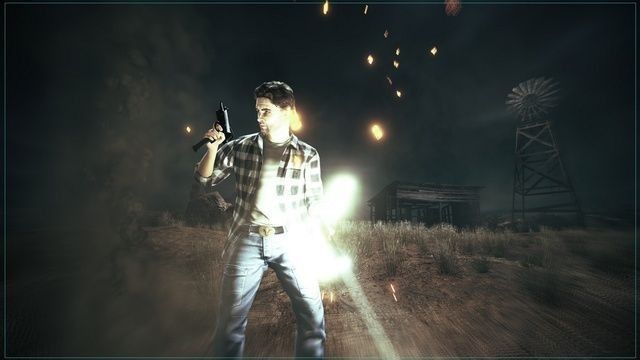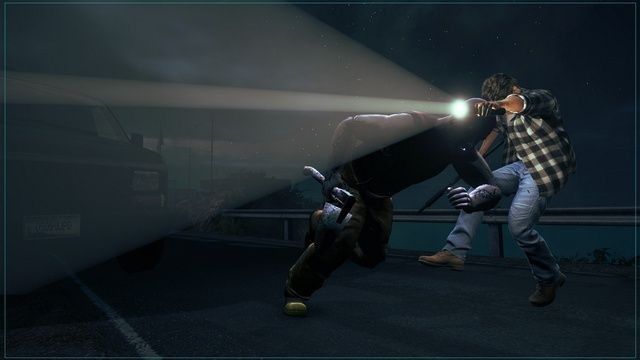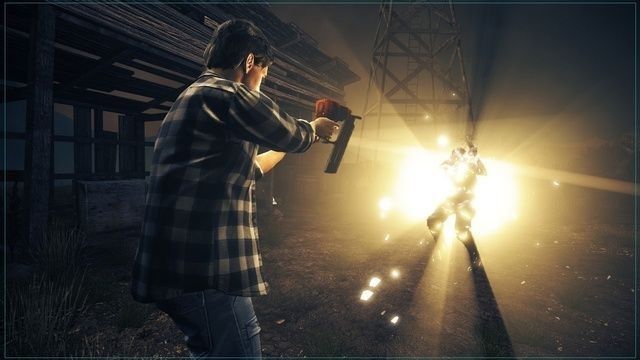Did you picture it? Because that’s Alan Wake’s American Nightmare; a brazen send up of The Twilight Zone from the perspective of its hapless writer. With an almost contemptuous amount of self awareness, American Nightmare is a horror adventure with more pulp than an [insert reference to oranges and/or paper].
 |
| Rural America is full of particle effects |
Having not played the previous Alan Wake, American Nightmare would have to serve as an introduction to Alan’s world, and as a standalone adventure, it’s very accessible. There are some vague references to the events of the prequel, but AN can be picked up without any confusion.
American Nightmare comes across a little bit like an inverse Max Payne, which is not hugely surprising, considering Remedy made them both. Even some of the stock “this door is locked!” sound effects are recognisable as the same, which isn’t to say the two titles are carbon copies, because they’re closer to distorted mirror images, aptly enough.
Unlike Max Payne, Alan’s not an ex-CIA genetically engineered astronaut cowboy; he’s a writer. Or so he likes to keep telling everybody. He does precious little actual writing, unless you count the rewriting of reality, and even then he plays it safe by working off his old hits. Hack.
While Max Payne was about gratuitous slow motion gun play, AN is about frantic torch shining and panicky self defence. Whereas Max Payne had surreal Twin Peak-esque horror lurking on the fringes through blurry TV sets, and the funny as hell, worst thing I can think of drug fuelled delusions of Max’s entrapment in his own narrative, these things take centre stage as Alan Wake really is trapped in a fictional world of his own devising, while his evil mirror image runs amok in the real world, the real world as we know it being snippets of radio shows and TV clips, courtesy of the murderous doppelganger channel.
Despite Alan’s insistence at being a writer, his tools of the trade seem to be less the pen, and more the gun and torch. With this in mind, much of the game’s tension comes from Alan’s lack of superhuman abilities; he can’t effortlessly evade bullets, getting out of the way of danger is hard and takes precision. Nor is Alan a killing machine. His greatest weapon might just be the light, his trusty torch being the bane of The Taken; the darkness infused menagerie of slasher movie caricatures and monster mash clichés that really don’t like Alan’s annoying habit of having a pulse.
The Taken, as avatars of darkness, hate the light, and this light vs. dark conflict is central to American Nightmare. In fact the ideas of motifs and symbols themselves are central to American Nightmare.
So when Mr. Wake uses his miraculous ability to focus his torch’s beam, The Taken stop dead in their tracks, unless something untoward occurs, like the fiends splitting in half, which is most ungentlemanly. That The Taken need to be exorcised of the darkness protecting them before they can be dealt with adds a clever twist; the only thing standing between you and undiluted evil is an AAA battery.
 |
| At times like this, Alan had wished he’d been an erotica writer instead of horror |
Having this everyday item be the only thing keeping death at bay is an effective vehicle for ramping up the pressure as it plays on and prolongs anticipation of the conflict, which is classic horror movie fare. AN excels at creating these back to the wall, dead end scenarios, where the pressure is steadily piled on, as Alan is encircled by mobs intent on redecorating the great outdoors with his insides.
It’s not so easy for Alan to outrun them, though he may find shelter in one of the various rejuvenating street lamps, fonts of light that they are. If Max Payne is John Woo, then Alan Wake is John Carpenter (minus all the synths), and American Nightmare absolutely nails the horror movie atmosphere of the relentless supernatural force bearing down on the stubborn everyman, with the only thing protecting him being some flimsy mystical rules.
American Nightmare isn’t outright scary, but it is stressful in a perversely enjoyable sort of way, and competently eerie. This eerie nature is due to a mix of deserted locales, the tense combat situations that constantly threaten to pop up, and the convincingly acted aforementioned video diary from Mr. Scratch, the bad Alan. For all its serial killer bravado and fear of the dark, American Nightmare’s most unsettling aspect is how subversive it is.
Part of the game revolves around finding manuscripts, each entry shedding more light on the story, which neatly justifies the hunt for them. The earnest journal entries tend to be more engaging than Alan’s purple prose, and the implications that maybe he’s not actually that great a writer, until the line starts to blur between fact and fiction within the narrative, which in a completely organic way, questions the nature of sentience, reality, free will and fate, and even the role of fiction.
American Nightmare features some deceptively excellent writing which dawns on the player as a revelation through the barely concealed sniggers of the narrator’s periodical spiel about champions of light and how ‘this could be anywhere in America’.
Mechanically, AN isn’t very complex, but it is both tense and engaging. The ‘puzzles’ if you can dare call them that, seeing as there’s no actual puzzling to be had beyond ‘push button until solved’, are basically exercises in connecting Alan’s occupation to in game activities. They work thematically, but they aren’t challenging. Even the scavenger hunt for manuscripts is sign posted when you get nearby (which is honestly something of a relief). The only real challenge in terms of the game itself is the combat, which is helpfully extended into Arcade Mode, a last stand survival mode at one of multiple classic horror movie locations, and the source of lots of replayability.
Though it might be seen as hand holding, American Nightmare doesn’t want you to get frustrated exploring for paper, just like it doesn’t want you to get annoyed with overly confusing puzzles. It wants you to experience its story, it wants you to be engaged by its concepts, and it wants you to be drawn into its world (so your evil double can take your place).
Alan Wake’s American Nightmare is massively repetitive. It’s repetitive. Repetitive. But that’s not a bad thing! American Nightmare is centred around a very tightly honed combat design and central motifs that are introduced, reintroduced and then exploded. Events never let up, and AN is paced without hesitation and only gains momentum as it progresses. There’s really very little time to even think about getting sick of proceedings. Its repetition is central to its theme and is never monotonous.
 |
| Alan was beginning to regret his choice of renovation project, but at least his nail gun paid for itself |
It doesn’t hurt that the gun play is extremely well realised, with each weapon feeling distinctive, and even, dare it be said, approaching realism. The animation also, bar the occasional ‘I’m looking at the ceiling’ conversation standby is great. Overall, American Nightmare is highly polished, with a consistently good quality in everything it does. It’s not the deepest game out there, but it strikes an admirable balance between cerebral thematic content and a pinpoint focus on action and atmosphere and the relationship between the two.
American Nightmare doesn’t hang around, but it doesn’t need to either. Judge this book by its cover; just make sure the cover you're thinking of is an Americana doused, enjoyably knowing schlock-fest, with a surprising philosophic tinge.
It’s a coin toss between Mr. Scratch’s smug smile at the end of his ‘tools of the trade’ video to Alan, or seeing The Taken cower from a flare’s light and Alan’s mighty plaid shirt.
Platform Played: PC
ALAN WAKE'S AMERICAN NIGHTMARE VERDICT
American Nightmare doesn’t hang around, but it doesn’t need to either. Judge this book by its cover; just make sure the cover you’re thinking of is an Americana doused, enjoyably knowing schlock-fest, with a surprising philosophic tinge.
TOP GAME MOMENT
It’s a coin toss between Mr. Scratch’s smug smile at the end of his ‘tools of the trade’ video to Alan, or seeing The Taken cower from a flare’s light and Alan’s mighty plaid shirt.




